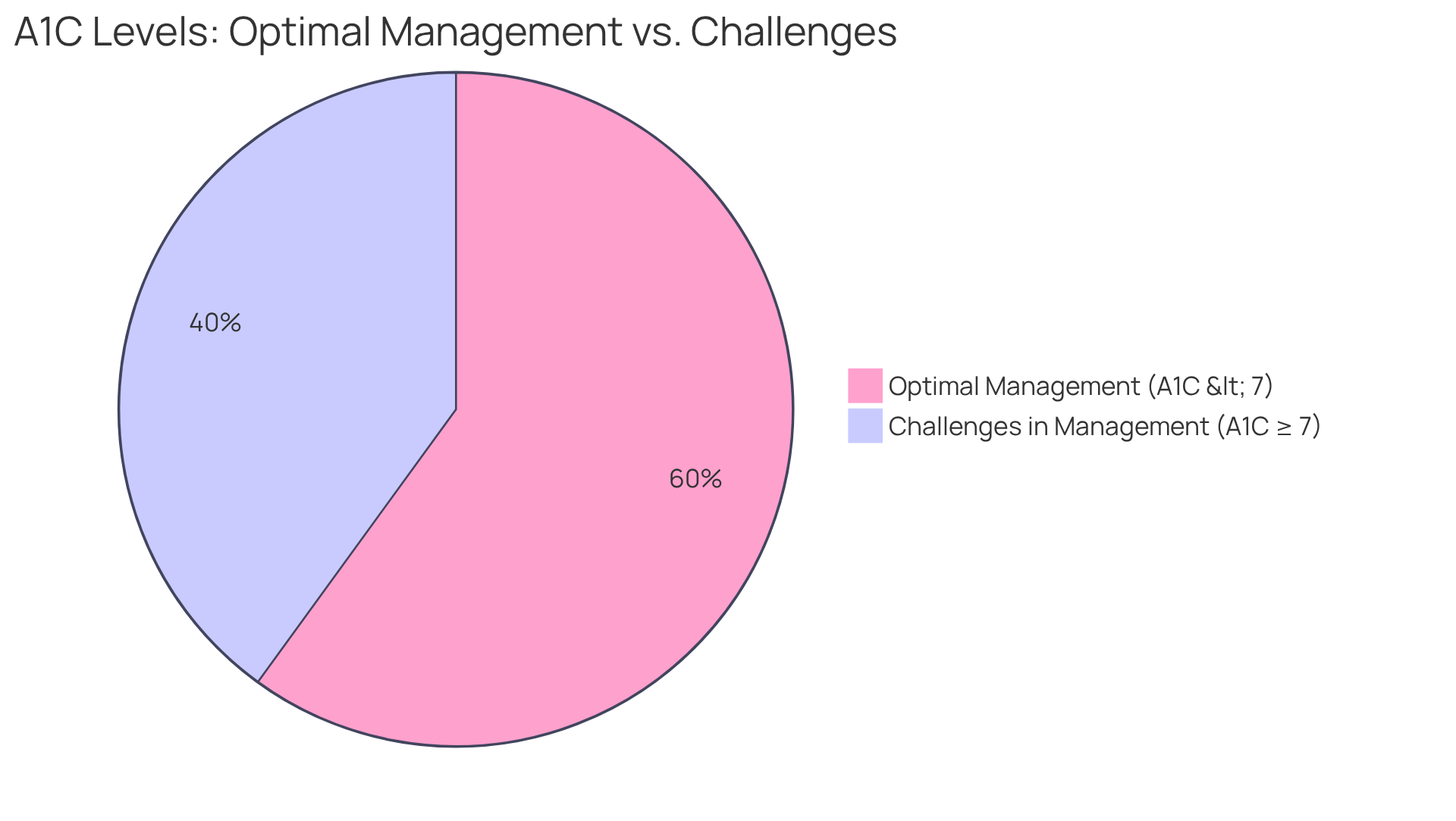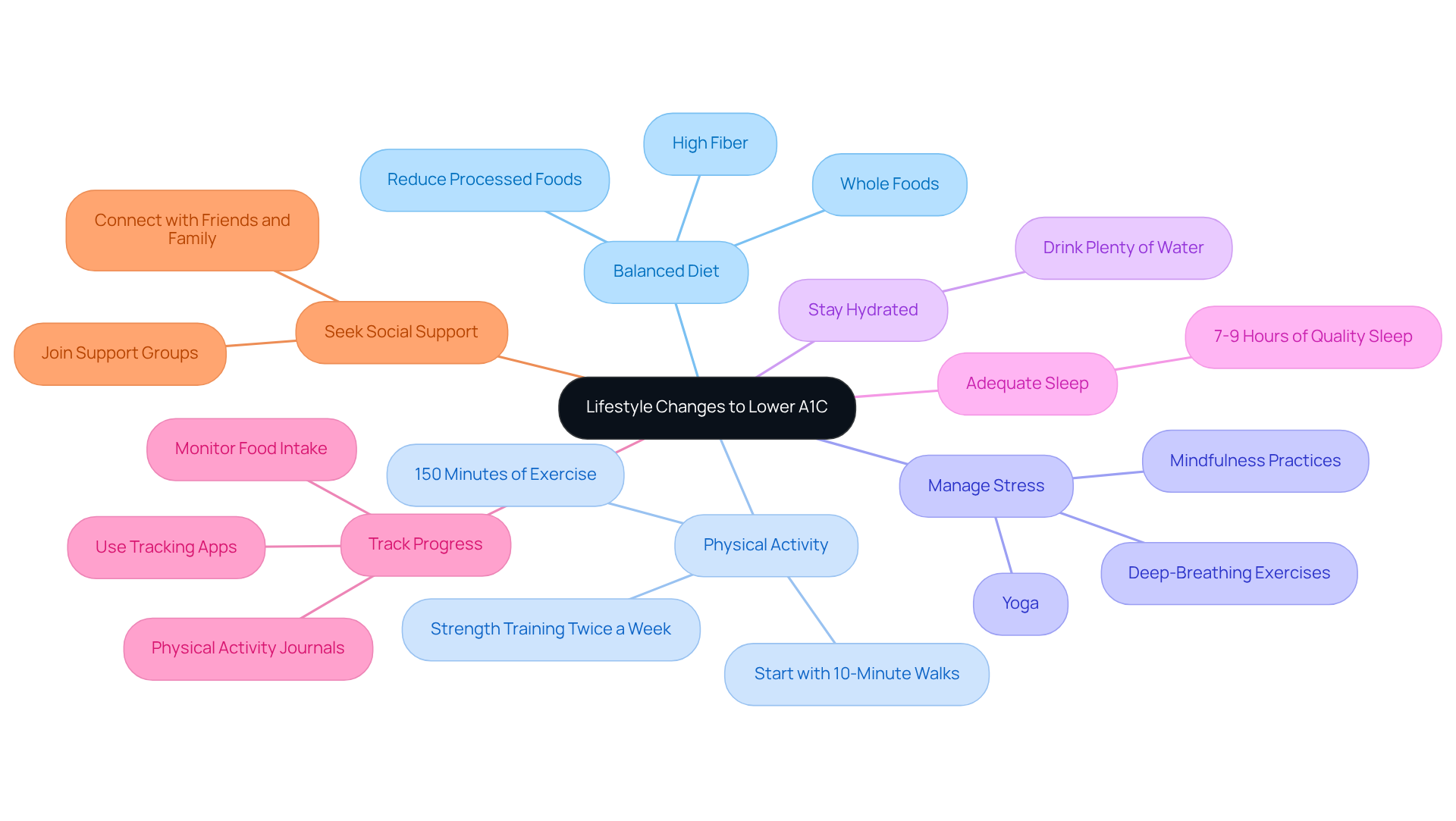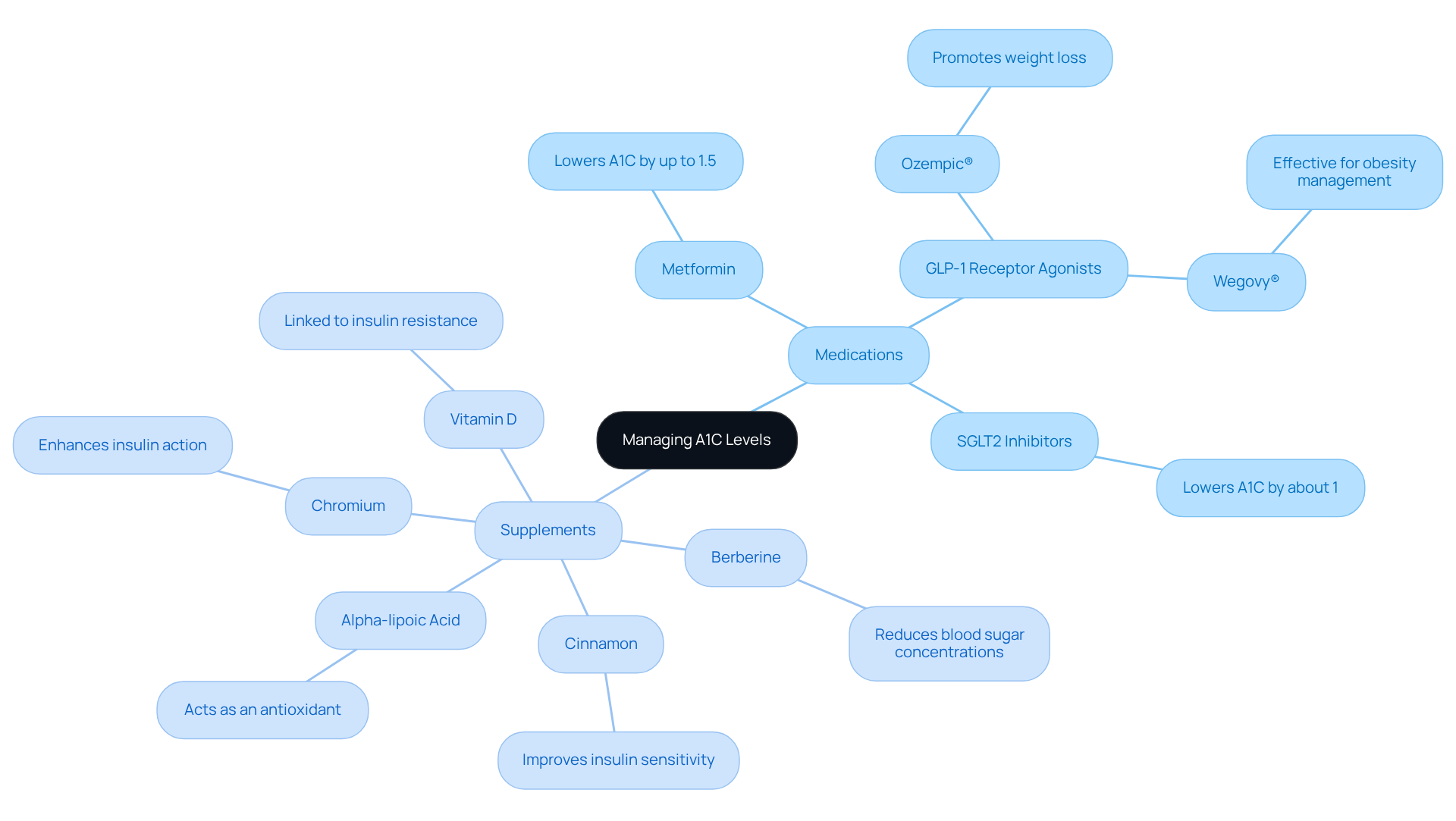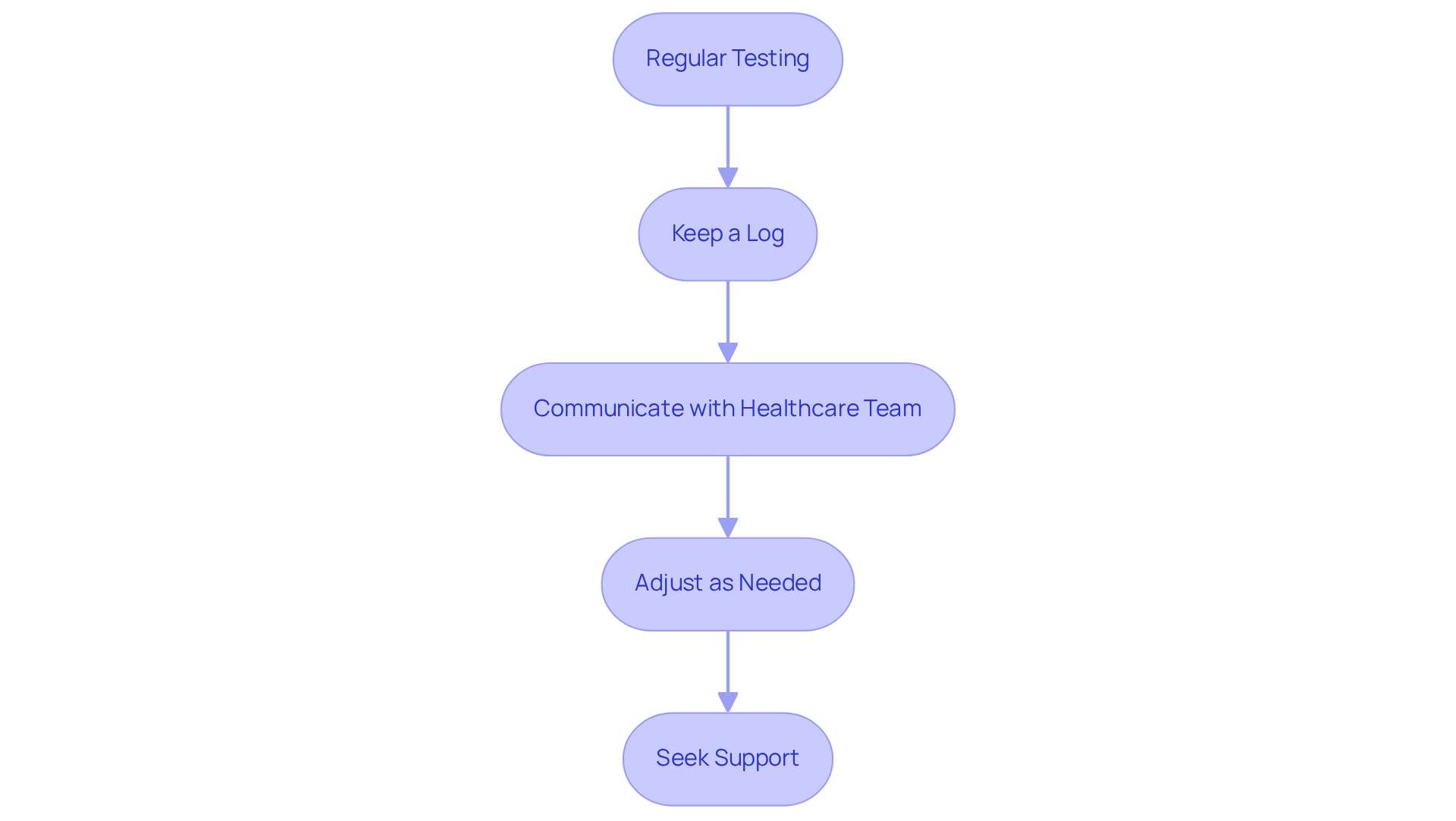Overview
Lowering your A1C levels can feel like a daunting journey, but we’re here for you. This article outlines four effective steps that can help you take control of your health:
- Adopting a balanced diet
- Increasing physical activity
- Managing stress
- Staying hydrated
These recommendations are not just suggestions; they are backed by evidence showing how lifestyle changes can significantly impact your glucose levels and overall well-being.
Imagine how empowering it would feel to make these changes! By embracing a balanced diet, you can nourish your body with the nutrients it needs. Increasing your physical activity doesn’t have to mean intense workouts; even small changes can make a big difference. Managing stress is crucial, as it plays a significant role in your health. And let’s not forget the importance of staying hydrated—it’s a simple yet effective way to support your body.
Together, we can achieve your goals. Remember, every small step counts, and you don’t have to do this alone. By incorporating these strategies into your daily routine, you’re not just managing diabetes; you’re also improving your overall health. Let’s take this journey together, one step at a time.
Introduction
Navigating the complexities of diabetes management can feel overwhelming, especially when trying to grasp the importance of the A1C test. This essential assessment not only reflects your average blood sugar levels over the past few months but also serves as a crucial indicator for effective diabetes control. Together, we can explore actionable strategies to help lower your A1C levels, from lifestyle modifications to medication options, empowering you to take charge of your health. But with so many approaches available, how can you determine the most effective path to achieving optimal A1C results? Let’s uncover this journey together.
Understand the A1C Test and Its Importance
The A1C test, also known as the hemoglobin A1C test, is a valuable tool that assesses your average glucose concentrations over the past two to three months. It’s expressed as a percentage, and higher percentages can indicate challenges in managing glucose levels. For most adults, an A1C reading below 7% is considered optimal for effective diabetes management. Understanding your A1C results is essential for lowering your A1C, as it enables you and your healthcare provider to evaluate the effectiveness of your diabetes management plan and make any necessary adjustments.
We know that navigating diabetes can feel overwhelming at times, but regular assessments—typically every three months—are recommended to help you track your progress and focus on lowering your A1C while ensuring that your glucose levels remain within the desired range. Remember, you’re not alone in this journey. Together, we can achieve your health goals and create a management plan that works best for you. Your health is important, and taking these steps can lead to a brighter, healthier future.
Implement Lifestyle Changes to Lower A1C
To effectively lower your A1C, consider implementing these lifestyle changes that can make a real difference in your health journey:
-
Adopt a Balanced Diet: Emphasize whole foods, including a variety of vegetables, whole grains, lean proteins, and healthy fats. Reducing processed foods, added sweeteners, and refined carbohydrates can be transformative. A diet high in fiber is especially beneficial, as it helps manage glucose levels and can lead to significant improvements in A1C.
-
Increase Physical Activity: Aim for at least 150 minutes of moderate aerobic exercise each week, such as brisk walking, cycling, or swimming. Incorporating strength training exercises at least twice a week can further enhance insulin sensitivity. Starting with a simple 10-minute walk after dinner can help you establish a regular routine, gradually increasing your activity. Always consult with your doctor before starting any new physical activities to ensure safety and receive personalized advice.
-
Manage Stress: Ongoing stress can negatively impact glucose levels. Engaging in stress-reducing practices such as mindfulness, yoga, or deep-breathing exercises can help maintain emotional balance and support your overall health.
-
Stay Hydrated: Make sure to drink plenty of water throughout the day. Staying hydrated is crucial for effective glucose management and can enhance your overall well-being.
-
Get Adequate Sleep: Strive for 7-9 hours of quality sleep each night. Insufficient sleep can adversely affect insulin sensitivity and blood sugar control, which is vital for diabetes management.
-
Track Your Progress: Regularly monitoring your food intake and physical activity is essential. Using tracking apps or journals can help you stay accountable and identify patterns that influence your A1C readings.
-
Seek Social Support: Connect with friends, family, or support groups to share your journey and stay motivated. Having a support system can significantly enhance your commitment to these lifestyle changes.
By embracing these lifestyle modifications, you can substantially improve your overall well-being while focusing on lowering your A1C levels. Remember, regular check-ins with your healthcare providers can help track your progress and provide ongoing support. Together, we can achieve your goals and make this journey a little easier.
Explore Medication and Supplement Options
Managing your A1C levels can feel overwhelming, but you’re not alone in this journey. In addition to making lifestyle changes, there are several medications and supplements that may assist you in lowering your A1C.
Medications can be an effective part of your plan. Commonly prescribed options include:
- Metformin
- GLP-1 receptor agonists like Ozempic® and Wegovy®
- SGLT2 inhibitors
These medications work in different ways to enhance insulin sensitivity, decrease glucose production, and promote weight loss, all contributing to lowering your A1C.
You might also consider incorporating some supplements into your routine. These dietary additions can support your efforts in managing glucose levels. For instance:
- Cinnamon may improve insulin sensitivity
- Berberine has been shown to effectively reduce blood sugar concentrations
- Alpha-lipoic acid acts as an antioxidant that can help reduce insulin resistance
- Chromium can enhance the action of insulin
- Vitamin D; reduced levels have been linked to insulin resistance, so ensuring adequate intake is important
Before starting any new medication or supplement, it’s crucial to consult with your healthcare provider. They can help ensure that any new additions align with your overall health plan. Remember, together, we can achieve your goals, and every step you take is a step toward better health.
Monitor Progress and Adjust Plans with Healthcare Support
Tracking your A1C readings and overall health is crucial for managing diabetes and lowering your A1C, and we understand that this journey can feel overwhelming. Here are some key steps to help you stay on track:
-
Regular Testing: It’s important to schedule A1C tests every three months or as advised by your healthcare provider. This regular testing not only helps you monitor your progress but also allows you to make necessary adjustments to your management plan. Remember, lowering your A1C measurement below 5.7% is essential for avoiding complications.
-
Keep a Log: Maintaining a daily record of your blood sugar readings, dietary intake, physical activity, and any medications or supplements taken can be incredibly beneficial. This detailed log can provide valuable insights for both you and your healthcare team, facilitating informed decisions about your treatment. Reflect on how this practice can empower you to take charge of your health.
-
Communicate with Your Healthcare Team: Regularly discussing your progress with your healthcare provider is vital. Sharing your log and any concerns fosters collaboration, allowing for a tailored treatment plan that meets your specific needs. Remember, effective communication empowers you to manage your health proactively, and we’re here for you every step of the way.
-
Adjust as Needed: Be open to modifying your lifestyle, medications, or supplements based on your A1C results and overall health. Flexibility is key to discovering what works best for you, particularly since certain medications can affect lowering your A1C. It is important to discuss specific target A1C levels with your healthcare provider for the purpose of lowering your A1C and aligning your goals with your overall health.
-
Seek support by joining a diabetes support group or working with a health coach to help you stay motivated and accountable on your journey to lowering your A1C. Engaging with others can enhance your experience and provide additional resources for managing your condition. Additionally, utilizing Continuous Glucose Monitors (CGMs) can be beneficial, as individuals using data from a CGM have shown to lose more weight compared to those without one. Together, we can achieve your goals and make this journey a positive experience.
Conclusion
Understanding and effectively managing A1C levels is crucial for anyone navigating diabetes. This article outlines a comprehensive approach to lowering A1C through a combination of lifestyle changes, medication options, and consistent monitoring. By prioritizing health, individuals can create a tailored management plan that fosters better glucose control and overall well-being.
Key strategies discussed include:
- Adopting a balanced diet rich in whole foods
- Increasing physical activity
- Managing stress
- Staying hydrated
- Ensuring adequate sleep
Have you considered how these small changes can make a significant impact on your health? Furthermore, exploring medication and supplement options can provide additional support in lowering A1C. Regular check-ins with healthcare providers, maintaining a detailed log of health metrics, and being open to adjustments are essential components of this journey.
Ultimately, the path to lowering A1C is a collaborative effort that empowers individuals to take charge of their health. By implementing these steps and seeking support, achieving optimal A1C levels becomes a realistic and attainable goal. Remember, taking action today can lead to a healthier tomorrow, reinforcing the importance of proactive diabetes management and the positive impact it can have on your life. Together, we can achieve your goals and foster a brighter future.
Frequently Asked Questions
What is the A1C test?
The A1C test, or hemoglobin A1C test, assesses your average glucose concentrations over the past two to three months and is expressed as a percentage.
Why is the A1C test important?
The A1C test is important because it helps evaluate the effectiveness of your diabetes management plan and indicates how well your glucose levels are being managed.
What is considered an optimal A1C reading for adults?
For most adults, an A1C reading below 7% is considered optimal for effective diabetes management.
How often should the A1C test be conducted?
Regular assessments of the A1C test are typically recommended every three months to help track progress and focus on lowering A1C levels.
What can I do if my A1C levels are high?
Understanding your A1C results allows you and your healthcare provider to evaluate your diabetes management plan and make necessary adjustments to lower your A1C levels.
How can I manage my diabetes effectively?
Managing diabetes effectively involves regular assessments, tracking your A1C levels, and working with your healthcare provider to create a management plan that suits your needs.





















